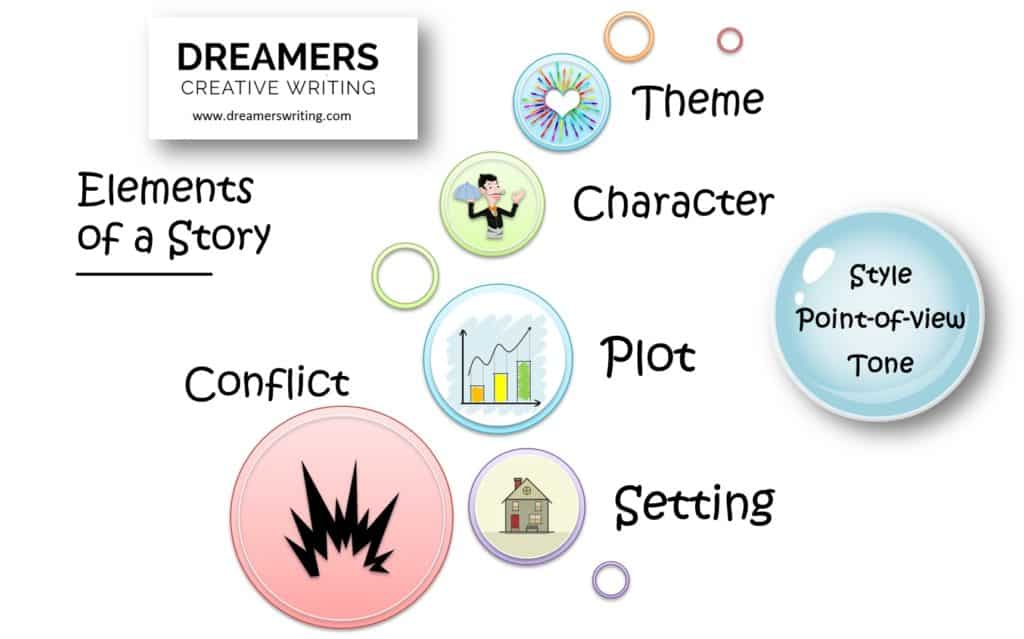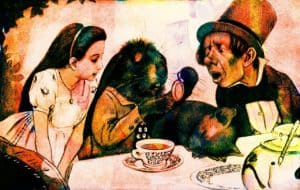8 Elements of a Story Explained
What are the 8 essential elements of a story?
- Setting
- Character
- Plot
- Conflict
- Theme
- Point-of-view
- Tone
- Style

Basic elements of a story
There are 5 elements of a story that are typically taught first in elementary school. These story elements are:
- Setting: Where and when is the story happening? Setting represents both the physical location but also the time (i.e. past, present, future) and the social and cultural conditions in which the characters exist. The setting can be used to create atmosphere and mood, as well as to influence character behavior and plot development.
- Character: A person or animal or really anything personified. There can be one main character or many, and they may have a backstory that has shaped and molded them. Secondary characters may also play a role, though not always. Characters can be described in terms of their physical appearance, personality, background, and motivations. They can also be dynamic (changing) or static (unchanging) throughout the story.
- Plot: The plot consists of the events that happen in the story. In a plot you typically find an introduction, rising action, a climax, the falling action, and a resolution. Plot is often represented as an arc. The plot is the backbone of the story and provides structure and direction for the narrative. It should be engaging and make the reader want to continue reading. If you want to learn about plot in detail, read the article: “What is a Plot.”
- Conflict: Every story must have a conflict, i.e. a challenge or problem around which the plot is based. Without conflict, the story will have no purpose or trajectory. Conflict can take many forms, such as person vs. person, person vs. nature, person vs. society, and person vs. self. The conflict should be well-developed and add tension and drama to the story.
- Theme: Idea, belief, moral, lesson or insight. It’s the central argument that the author is trying to make the reader understand. The theme is the “why” of the story. Themes can be universal (applicable to all) or specific to a certain culture or time period. They should be explored through the events of the story and can offer insights into human behavior or the human condition.
Advanced elements of a story
There are 3 advanced elements of a story that are typically taught in high school. These story elements are:
- Point-of-view: “Who” is telling the story? First person (“I”) or third person (“he/she/it”). Limited (one character’s perspective), multiple (many characters’ perspectives) or omniscient (all knowing narrator). Second person (“you”) is not often used for writing stories. The choice of point-of-view can greatly impact the reader’s experience of the story, and can affect how they relate to the characters and events.
- Tone: This is the overall emotional “tone” or meaning of the story. Is it happy, funny, sad, or depressed? There are multiple ways to portray tone including through word and grammar choices, choice of theme, imagery and description, symbolism, and the sounds of the words in combination (i.e. rhyme, rhythm, musicality). The tone should be consistent throughout the story and should match the mood and atmosphere created by the setting, plot, and characters.
- Style: This is how things are said. Word choices, sentence structure, dialogue, metaphor, simile, and hyperbole are all aspects of style. Style contributes significantly to tone. Style can be used to create unique and memorable prose, and can help to differentiate one writer’s work from another’s. It can also contribute to the tone and overall feel of the story.
Mastering the Story Elements

Understanding these 8 elements of a story is crucial for anyone interested in writing, analyzing, or enjoying literature. From the setting and characters to the plot, conflict, theme, point-of-view, tone, and style, each element plays a critical role in crafting a compelling story. Whether you’re a beginner or a seasoned writer, mastering these story elements will help you create stories that captivate and resonate with your readers. So, grab your pen or keyboard, and let your imagination run wild!
Importance of backstory in storytelling
Backstory is a vital element of a compelling story, adding depth and complexity to characters and increasing emotional investment from readers.
To learn more about BACKSTORY, read the article: “The Importance of Backstory in Storytelling“
Resources related to elements of a story
To learn about PLOT in detail, read the article: “What is a Plot of a Story?“
Are you teaching this topic? Here’s a perfectly printable PDF of the elements of a story.
Looking for a book on this topic? Try The Elements of Story: Field Notes on Nonfiction by New York Times Editor, Francis Flaherty.
Need to reinforce your structural techniques? Visit The 7 Main Story Elements and Why They Matter, a blog post by New York Times bestselling author, Jerry B. Jenkins.
*This article updated on April 30, 2023.